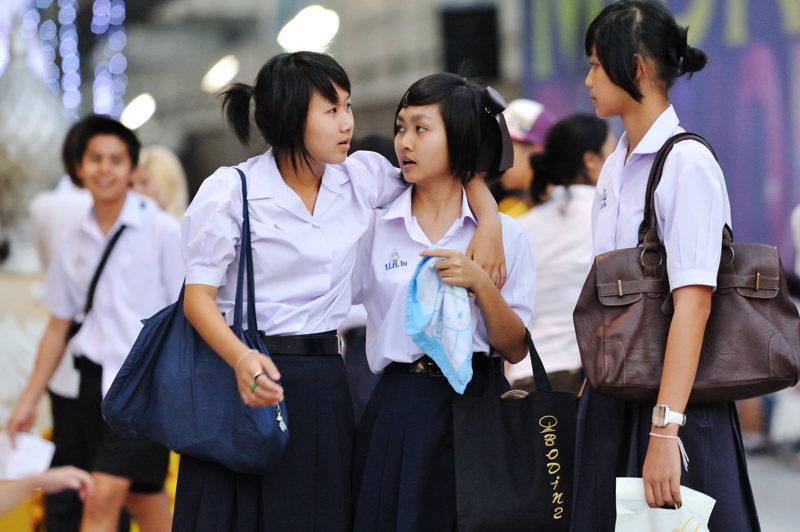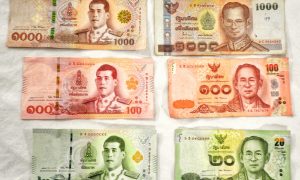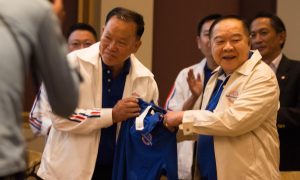This is a translated and edited version of an article originally submitted in Thai. The original Thai article can be read below. ฉบับภาษาไทยอยู่ข้างล่าง
On 1 May, the Education Ministry published its new Regulations on Hairstyles of Students B.E. 2563 (2020) in the Royal Gazette. The document updates directives that for decades allowed schools and other education institutions to oblige male students to maintain army-style crew cuts and female students to maintain bobs no longer than their earlobes.
Notable changes in the new regulations include Section 4, which allows students of all genders to wear longer hairstyles. For male students, hair on the side and back of the head should not extend beyond the base of the neck. Students must also maintain “neat” hair styles, which means no perms, hair dye, moustaches or beards, or other special styling such as shaved symbols. Meanwhile Sections 5 and 7 confer school boards and administrators the discretion to install their own specific regulations on the hairstyles of students, provided these do not conflict with the Ministry’s directives.
But what is most interesting about the new regulations is an opening statement which states an intention to “protect the human dignity” of students. Students who mobilised over the last decade have not been fighting merely for the choice to grow out their crew cuts. Their claim has rather been the following: “I view my hair as an organ of my own body”. A student should choose to make changes to their body, rather than be forced.
In other words, the issue of student hairstyles has expanded beyond the relaxation of regulations to the question: “Does the requirement that students cut their hair infringe on the rights and liberties of students under a liberal-democratic framework?” Liberal-democratic philosophies emphasise the concept of “the individual”, an actor with thoughts of their own who is able to exercise their rights and liberties as they see fit provided they do not infringe on those of others.
Bodily autonomy is enshrined in several legal documents, from Article 28 of the 2017 Thai Constitution to Article 28 of the UN Convention on the Rights of the Child which states that school discipline should be “administered in a manner consistent with the child’s human dignity” (Thailand signed onto the Declaration in 1992.) Thai students have not merely hoped for the modernisation or relaxation of regulations, but staked claims to rights, liberties and human dignity: “We, in the status of individuals of a free world, have the right and freedoms to wear our hair as we like.”
The new regulations have been well received by several mainstream news outlets as well as the Thai cyber-verse. They are undoubtedly a step in the right direction against a culture pervading Thai institutions that subjects students to strict discipline and obedience to orders, sometimes at the expense of their rights and liberties. However, some doubts linger over whether the implementation of the regulations will actually broaden the choices that students have when it comes to their bodies, let alone stay true to the spirit of protecting their dignity.
A brief history of student resistance against hairstyle regulations
Over the past decade, Thai students have mobilised in a number of forms, especially over social media, to push the issue of hairstyle regulations into the public eye. The student groups Thailand Educational Revolution Alliance (TERA) and Education for Liberation of Siam have led this movement.
Before the latest changes, regulations on the hairstyles of students were contained under two documents. First, the Ministerial Regulations No. 1, B.E. 2515 (1972), promulgated under the authority of the Order of the National Executive Council No. 132 during the dictatorship of Thanom Kittikachorn, stipulated that long hair on both males and females was unbefitting the status of a student. The regulations mandated that male students maintain crew cuts close to the scalp, while females maintain bobs no longer than their earlobes.
The Ministerial Regulations No. 2, B.E. 2518 (1975) made some amendments to these rules. For male students, the new directive removed the requirements in the 1972 regulations that hair at the front and crown of the head not exceed 5 centimetres, and hair surrounding the crown be cut close to the scalp. It stipulated only that male students were not allowed to grow the sides and back of their hair longer than the nape of their necks. There were no changes for females.
Despite the promulgation of these new regulations however, the 1972 regulations appeared to remain better known in society and many schools continued to adhere to them. In 2003, the Order of the National Executive Council No. 132 was repealed by the Child Protection Act. However, the Ministerial Regulations No. 2, B.E. 2518 (1975) remained in force under interim measures.
The student movement began mobilising from 2012 to reform hairstyle regulations, and enjoyed a minor victory during the government of Yingluck Shinwatra. In 2013, the Education Ministry led by Phongthep Thepkanjana circulated a notice to ensure that all schools were enforcing the same standards—namely the second edition of the Ministry of Education’s regulations. But indications from the Ministry that it would allow greater flexibility when it came to the hairstyles of female students were interrupted by the coup of the National Council for Peace and Order (NCPO).
After of the 2014 coup, officials rarely engaged in public discussion on the subject of student hairstyle regulations, reflecting the flourishing of a militaristic education philosophy promoting obedience and unity (as exemplified in the passage of policies such as the promotion of “12 core values for Thais.”) Still, the minor victories of the past emboldened the student movement to continue fighting. Education for Liberation of Siam, for example, organised the exhibition “Education is Killing Me” at the Bangkok Art and Culture Centre to draw attention to the suppression of freedom of thought in school curriculums. The activities of student activists combined with a steady stream of news stories on the aggressive enforcement of school rules, such as through forced head shavings, to drive criticism across social media.
Problems in the new regulations
From the perspective of some student activists, the new regulations are a “second victory”. But how genuinely will they protect rights and liberties? While the document states an intention to protect human dignity, this intention is qualified by other simultaneous objectives: “to clarify existing rules on the operation of places of education, to reflect changing times, and to ensure that students behave correctly.” If the regulations were amended with several simultaneous goals, which values should educational institutions give precedent to?
While the new regulations have loosened past rules, they still require that male students grow out their hair “neatly and appropriately” and that females tie up long hair. Article 7 of the new regulations also preserves the prerogative of school administrators to produce their own specific regulations on hair provided they do not conflict with the Ministry’s directives, giving discretionary power to education institutions to continue defining hairstyles which are “correct and appropriate.”
Do such directives aim to protect the rights, liberties and human dignity of students in accordance with liberal democratic principles? Or do the regulations refer to “human dignity” merely to give a veil of legitimacy to their instructions, while allowing education institutions to continue obstructing the bodily autonomy of students? In the end, school administrators remain the ones who decide what should be done with the hair on the top of students’ heads.
Recommendations
Though the Ministry of Education’s Regulations on Student Hairstyles (2020) are not without problems, we can still leverage them in the fight to make hairstyles the choice of students themselves. Civil society and students can cite the regulations to pressure the Office of the Education Ministry, which has the power to deliberate and make rulings on conflict over the regulations, to compel schools across the country to consider protecting the rights, liberties and human dignity of students as the “highest aim” of the regulations. We should also campaign for concrete appeals mechanisms in schools.
More importantly, the student movement should mobilise for the repeal of these insensible regulations, which should not exist in the first place, and demand that those in power genuinely return the rights and freedoms of the body to students. The new regulations still guarantee school administrators the same prerogatives, a legacy descended from the announcements of former juntas who used their dictatorial powers to control the bodies of students.
A guarantee to bodily autonomy is only genuine when students themselves have the prerogative to make choices about their bodies. Conferring that choice will push Thai schools to finally learn how to respect difference in students. After all, our hairstyles don’t hurt anyone else.
The authors are members of a group of students preparing to sue the Ministry of Education over alleged infringements to their rights facilitated by the regulations on student hairstyles.
เมื่อวันที่ 1 พฤษภาคม ที่ผ่านมา ระเบียบกระทรวงศึกษาธิการ ว่าด้วยการไว้ทรงผมนักเรียน พ.ศ. 2563 ได้ถูกประกาศลงในราชกิจจานุเบกษาเป็นที่เรียบร้อยซึ่งจะเริ่มใช้ตั้งแต่วันที่ 2 พฤษภาคม พ.ศ. 2563 เป็นต้นไป
เรื่องนี้กลายเป็นประเด็นใหญ่ที่ได้รับการถกเถียงกันในโลก Social Media โดยทันที เพราะเป็นการเปลี่ยนแปลงกฎระเบียบของกระทรวงศึกษาธิการว่าด้วยเรื่องทรงผมนักเรียนที่มีมาตั้งแต่อดีต ที่ทำให้ทางโรงเรียนหรือสถานศึกษาสามารถออกกฎระเบียบให้นักเรียนชายต้องตัดผมสั้นเกรียน และนักเรียนหญิงต้องตัดผมสั้นเสมอติ่งหู
การเปลี่ยนแปลงครั้งนี้สร้างความหวังที่จะยุติเรื่องราวอันทำให้นักเรียนจำนวนไม่น้อยต้องทนทุกข์ เสียงที่ยอมรับให้มีการแก้ไขระเบียบว่าด้วยทรงผมนักเรียนดูจะมากขึ้นทุกที แม้จะมีการแสดงความคิดเห็นจากฝั่งที่ไม่เห็นด้วยกับการออกระเบียบกระทรวงศึกษาธิการฯ ครั้งนี้ก็ตาม
ใจความสำคัญของระเบียบกระทรวงศึกษาธิการฉบับนี้ ได้แก่ ข้อ 4 ที่ให้นักเรียนชายและหญิงสามารถไว้ผมสั้นหรือยาวก็ได้ โดยผมด้านหลังของนักเรียนชายต้องไม่ยาวเกินตีนผม ส่วนนักเรียนหญิงให้รวบผมให้เรียบร้อยหากไว้ผมยาว แต่ทั้งนักเรียนชายและหญิงต้องมีทรงผมที่ “เรียบร้อย” กล่าวคือ ไม่ดัดผม ย้อมสีผม ไว้หนวดไว้เครา หรือกระทำการใด ๆ กับทรงผมที่ไม่เหมาะกับการเป็นนักเรียน ตามข้อ 5 และข้อ 7 ซึ่ง อนุญาตให้คณะกรรมการสถานศึกษาหรือคณะกรรมการบริหารศึกษาสามารถใช้ดุลพินิจในการออกระเบียบทรงผมที่มีความเฉพาะเจาะจง (กับสถานศึกษาของตน) ได้ แต่ต้องไม่ขัดแย้งกับระเบียบกระทรวงศึกษาธิการฉบับนี้
ทรงผม – สิทธิและเสรีภาพในร่างกายของนักเรียน ?
การต่อสู้เรียกร้องของเหล่านักเรียนในรอบทศวรรษที่ผ่านมา ไม่ได้เป็นเพียงการต่อสู้เพื่อให้แก้ไขจากทรงผมเกรียนเป็นรองทรง หรือการแก้ไขจากผมสั้นเป็นผมยาวเท่านั้น หากแต่มีการยกประเด็นว่า “ผมถือเป็นอวัยวะส่วนหนึ่งของร่างกายนักเรียน” ดังนั้น การตัดผมของนักเรียนควรที่มาจากการตัดสินใจเปลี่ยนแปลงสภาพอวัยวะร่างกายด้วยความคิดของตัวนักเรียนเอง ไม่ได้มาจากการถูกบังคับทั้งทางตรงและทางอ้อมจากสิ่งใด ๆ
ประเด็นดังกล่าวขยายขอบเขตไปไกลกว่าเพียงเรื่องการแก้ไขระเบียบทรงผมนักเรียนให้ผ่อนปรนขึ้น หากแต่ขยายไปจนถึงเรื่องที่ว่า “การกำหนดกฎระเบียบให้นักเรียนต้องมีการตัดผมนั้น เป็นการขัดต่อสิทธิและเสรีภาพของนักเรียน ตามแนวคิดเสรีนิยมประชาธิปไตยหรือไม่ ?”
แนวคิดเสรีนิยมประชาธิปไตย เน้นความคิดในเชิง “Individualism” ซึ่งมองมนุษย์เป็นปัจเจก กล่าวคือ มนุษย์แต่ละคนย่อมมีความคิดเป็นของตนเองได้ และสามารถใช้สิทธิและเสรีภาพของตนเองได้อย่างเสรี ตราบที่ไม่เป็นการละเมิดสิทธิและเสรีภาพของผู้อื่น โดยแนวคิดลักษณะนี้ก็ได้รับการสะท้อนออกมาผ่านบทบัญญัติของเอกสารทางกฎหมายที่เป็นลายลักษณ์อักษรต่าง ๆ เช่น คำประกาศว่าด้วยสิทธิมนุษยชนและพลเมือง ค.ศ. 1789 (Déclaration des droits de l’homme et du citoyen) ปฏิญญาสากลว่าด้วยสิทธิมนุษยชน (Universal Declaration of Human Rights หรือ UDHR) รวมถึงรัฐธรรมนูญแห่งราชอาณาจักรไทยหลายฉบับ ซึ่งการตัดสินใจเรื่องทรงผมของตัวนักเรียน ควรที่จะเป็นไปตามแนวคิดดังกล่าว คือ “ให้นักเรียนสามารถตัดสินเรื่องร่างกายด้วยตนเอง”
นอกจากนั้น ทรงผมของนักเรียนยังเกี่ยวข้องกับ “สิทธิและเสรีภาพในร่างกาย” ของนักเรียน ซึ่งสิทธิเสรีภาพประการนี้ ได้ถูกรับรองและคุ้มครองไว้ในเอกสารทางกฎหมายต่าง ๆ เช่น รัฐธรรมนูญแห่งราชอาณาจักรไทย พุทธศักราช 2560 มาตรา 28 ปฏิญญาสากลว่าด้วยสิทธิมนุษยชน ข้อ 3 รวมถึงยังเกี่ยวข้องกับ “การวางกฎระเบียบของสถานศึกษาให้เคารพศักดิ์ศรีความเป็นมนุษย์” ตามข้อ 28 ของอนุสัญญาว่าด้วยสิทธิเด็ก (Convention on the Rights of the Child) ซึ่งประเทศไทยได้ให้สัตยาบัน เมื่อวันที่ 12 กุมภาพันธ์ พ.ศ. 2535 อีกด้วย
การมีอยู่ของกฎระเบียบว่าด้วยทรงผมของนักเรียน จึงอาจตีความได้ว่า เป็นการขัดหรือแย้งกับเอกสารกฎหมายที่เป็นลายลักษณ์อักษรต่าง ๆ ไม่ว่าจะเป็นรัฐธรรมนูญของประเทศไทย ที่ถือเป็นกฎหมายสูงสุดของประเทศ ตามแนวคิด “Supremacy of the Constitution” และถือเป็นเครื่องมือในการคุ้มครองสิทธิและเสรีภาพของประชาชน ตามแนวคิด “รัฐธรรมนูญนิยม” (Constitutionalism) รวมไปถึงเอกสารทางกฎหมายระหว่างประเทศต่าง ๆ อีกด้วย
ดังนั้น การเรียกร้องของนักเรียน จึงไม่ได้เพียงหวังให้กฎระเบียบทันสมัยหรือผ่อนปรนขึ้น หากแต่เป็นไปเพื่อทวงถามให้ได้มาซึ่งสิทธิเสรีภาพและศักดิ์ศรีความเป็นมนุษย์ว่า “พวกเขา ในฐานะปัจเจกชนแห่งโลกเสรีนิยม มีสิทธิและเสรีภาพในการกำหนดทรงผมของตัวเองได้ โดยไม่ต้องมีอุปสรรคจากกฎระเบียบใด ๆ”
สื่อมวลชนหลายแขนงและสังคมออนไลน์บางส่วนดูจะมองการเปลี่ยนแปลงครั้งนี้ในแง่บวก (ซึ่งก็มีแง่บวกเกิดขึ้นจริง) อย่างไรก็ตาม ระเบียบกระทรวงศึกษาธิการฉบับใหม่นี้ ก็มีข้อกังขาหลายประการว่า จะสามารถถูกนำไปปฏิบัติให้เป็นไปตามเจตนารมณ์แห่งการคุ้มครองศักดิ์ศรีความเป็นมนุษย์ และจะสามารถสร้างความเปลี่ยนแปลงในเรื่องทรงผมของนักเรียนได้จริงหรือไม่
ประวัติศาสตร์การต่อสู้เรื่องทรงผมของนักเรียนไทย
การเปลี่ยนแปลงเรื่องทรงผมนักเรียนมีลักษณะเป็นพลวัต (ไม่หยุดนิ่ง) มาโดยตลอด ตั้งแต่มีการเคลื่อนไหวของขบวนการนักเรียนไทยในช่วงทศวรรษที่ผ่านมาผ่านช่องทางต่าง ๆ โดยเฉพาะการใช้ Social Media ในการเคลื่อนไหวเพื่อผลักดันให้ประเด็นนี้กลายเป็นประเด็นสาธารณะ จนนำมาสู่การเปลี่ยนแปลงในหลายอย่าง (ซึ่งการเคลื่อนไหวของสมาพันธ์นักเรียนไทยเพื่อการปฏิวัติระบบการศึกษาไทย และกลุ่มการศึกษาเพื่อความเป็นไท ถือเป็นแกนหลักในเรื่องนี้)
กฎระเบียบว่าด้วยทรงผมของนักเรียนก่อนหน้านั้น มีอยู่ด้วยกัน 2 ฉบับที่ประกาศออกมา ได้แก่
- กฎกระทรวง (ศึกษาธิการ) ฉบับที่ 1 (พ.ศ. 2515) ที่ออกตามความในคำสั่งคณะปฏิวัติ ฉบับที่ 132 ลงวันที่ 22 เมษายน พ.ศ. 2515 ซึ่งกำหนดให้การไว้ผมยาวของนักเรียนชายและนักเรียนหญิง เป็นการแต่งกายที่ไม่เหมาะสมแก่สภาพของนักเรียน ตามความในข้อ 4 แห่งประกาศของคณะปฏิวัติ ฉบับที่ 132 สร้างผลให้นักเรียนชายจะต้องตัดผมเกรียนติดหนังศรีษะ ส่วนนักเรียนหญิงก็ต้องตัดผมสั้นเสมอติ่งหูของตนเอง หรือหากทางโรงเรียนหรือสถานศึกษาใดอนุญาตให้ไว้ยาวเกินกว่านั้น ก็ต้องให้รวบผมให้เรียบร้อย
- กฎกระทรวง (ศึกษาธิการ) ฉบับที่ 2 (พ.ศ. 2518) ที่ออกตามความในประกาศของคณะปฏิวัติ ฉบับที่ 132 ลงวันที่ 22 เมษายน พ.ศ. 2515 ซึ่งมีความเปลี่ยนแปลงบางส่วน กล่าวคือ ยกเลิกข้อกำหนดให้นักเรียนชายไว้ผมข้างหน้าและกลางศีรษะยาวไม่เกิน 5 เซนติเมตร และชายผมรอบศีรษะตัดเกรียนชิดผิวผนังและ โดยกำหนดแต่เพียงห้ามนักเรียนชายไว้ผมยาวจนด้านข้างและด้านหลังยาวเลยตีนผม แต่ไม่ได้มีการเปลี่ยนแปลงเรื่องทรงผมของนักเรียนหญิง
(อย่างไรก็ตาม การให้นักเรียนชายต้องตัดผมเกรียนตามกฎกระทรวง (ศึกษาธิการ) ฉบับที่ 1 ดูจะเป็นที่ถูกพูดถึงและเข้าใจในสังคมมากกว่า)
ซึ่งต่อมา ในปี พ.ศ. 2546 ประกาศของคณะปฏิวัติ ฉบับที่ 132 ได้ถูกยกเลิกโดยพระราชบัญญัติคุ้มครองเด็ก พ.ศ. 2546 แต่กฎกระทรวง (ศึกษาธิการ) ฉบับที่ 2 (พ.ศ. 2518) ดังกล่าว ยังคงใช้บังคับต่อไปได้ ตามเฉพาะกาลในมาตรา 88 ของพระราชบัญญัติคุ้มครองเด็ก พ.ศ. 2546
หากจะมองในแง่ดี การเคลื่อนไหวของขบวนการนักเรียนตั้งแต่ปี พ.ศ. 2555 เพื่อทำให้เกิดความเปลี่ยนแปลงเรื่องระเบียบทรงผมนักเรียน ก็ถือว่าเคยได้ชัยชนะ (เล็ก ๆ) มาแล้วครั้งหนึ่ง ในสมัยรัฐบาลยิ่งลักษณ์ ชินวัตร เมื่อช่วงปี พ.ศ. 2556 ที่กระทรวงศึกษาธิการ (พงศ์เทพ เทพกาญจนา ดำรงตำแหน่งรัฐมนตรีว่าการกระทรวงฯ ในขณะนั้น) ได้มีการออกหนังสือเวียนเพื่อเป็นการแจ้งและซักซ้อมความเข้าใจในเรื่องทรงผมของนักเรียน เพื่อให้โรงเรียนต่าง ๆ ปฏิบัติให้เป็นไปในแนวทางเดียวกัน กล่าวคือ ให้ยึดกฎกระทรวง (ศึกษาธิการ) ฉบับที่ 2 (พ.ศ. 2518) ที่ให้นักเรียนชายสามารถไว้ผมรองทรงได้ ไม่ต้องผมเกรียนเสมอไป และการไว้ผมของนักเรียนหญิงให้เป็นไปตามที่แต่ละระเบียบของโรงเรียนกำหนด รวมถึงได้มีความพยายามในการดำเนินการแก้ไขเรื่องทรงผมนักเรียนหญิงให้มีความยืดหยุ่นมากยิ่งขึ้น (แต่ไม่ทันจะได้ทำ ก็เกิดเหตุการณ์ที่คณะรักษาความสงบแห่งชาติ (คสช.) ยึดอำนาจรัฐบาลที่มาจากการเลือกตั้งของยิ่งลักษณ์ ชินวัตรเสียก่อน)
ภายหลังการทำรัฐประหาร ในปีพ.ศ. 2557 เรื่องของกฎระเบียบว่าด้วยทรงผมของนักเรียนก็ไม่ได้ถูกนำมาพูดถึง กลายเป็นเรื่องที่ถูกซุกซ่อนไว้ใต้พรม สอดคล้องกับการสร้างยุคแห่งความเฟื่องฟูของการกลับไปสู่แนวคิดการศึกษาแบบ “ทหารนิยม” ที่สะท้อนผ่านนโยบายการศึกษาต่าง ๆ เช่น เรื่องค่านิยม 12 ประการ เป็นต้น
อย่างไรก็ตาม การเคลื่อนไหวเพื่อเรียกร้องให้มีการแก้ไขกฏระเบียบว่าด้วยทรงผมนักเรียนก็ยังคงมีมาโดยตลอด ก้าวเล็ก ๆ แห่งความสำเร็จที่เกิดขึ้นก่อนหน้า ทำให้ขบวนการนักเรียนยังคงต่อสู้ตลอดมา ตัวอย่างล่าสุดคือการที่ “กลุ่มการศึกษาเพื่อความเป็นไท” ได้ทำการแสดงนิทรรศการเชิงสัญลักษณ์ชื่อว่า “การศึกษาฆ่าฉัน” ที่บริเวณลานหน้าหอศิลปกรุงเทพฯ เพื่อสะท้อนความไร้สาระของเนื้อหาและการบังคับใช้กฎระเบียบต่าง ๆ ของโรงเรียนที่ทำร้ายชีวิตของนักเรียนไทย รวมถึงสะท้อนการละเมิดสิทธิมนุษยชนต่าง ๆ ที่แฝงอยู่ในระบบศึกษาไทย
จากการเคลื่อนไหวของบรรดากลุ่มนักเรียนที่มีมาตลอดตั้งแต่ช่วงหลังการทำรัฐประหารจนถึงช่วงที่มีการเลือกตั้งครั้งใหม่เมื่อวันที่ 24 มีนาคม พ.ศ. 2562 ประกอบกับการนำเสนอข่าวการละเมิดสิทธิและเสรีภาพของนักเรียนในเรื่องทรงผมที่มีมาอย่างต่อเนื่องในข่าว ซึ่งได้รับการวิพากษ์วิจารณ์ผ่านสังคมออนไลน์อย่างมาก (โดยเฉพาะการแสดงความเห็นทาง Twitter ผ่าน Hashtags ต่าง ๆ) ในที่สุด ณัฏฐพล ทีปสุวรรณ รัฐมนตรีว่าการกระทรวงศึกษาธิการคนปัจจุบันก็ได้ทำการออกระเบียบกระทรวงศึกษาธิการว่าด้วยเรื่องทรงผมของนักเรียนฉบับใหม่ขึ้นมา
จุดเด่นที่น่าสนใจของระเบียบฉบับนี้ คือการกำหนดเจตนารมณ์ในเรื่อง “การคุ้มครองศักดิ์ศรีความเป็นมนุษย์” รวมถึงการสร้างความยืดหยุ่นในเรื่องการไว้ผมของนักเรียนไทยที่ดูจะมากขึ้น ซึ่งมองในแง่ความสำเร็จของการเคลื่อนไหวจากบรรดานักเรียน ก็อาจถือเป็น “ชัยชนะครั้งที่สอง” ของขบวนการนักเรียนไทยก็ได้
ทว่า… ชัยชนะครั้งนี้ เป็นชัยชนะที่แท้จริงอย่างนั้นหรือ ?
ปัญหาเรื่องความไม่ชัดเจนของคุณค่าสูงสุดที่ควรยึดถือ
แม้ระเบียบฉบับนี้ จะกำหนดเจตนารมณ์ในเรื่องการคุ้มครองศักดิ์ศรีความเป็นมนุษย์ รวมถึงสร้างความยืดหยุ่นในเรื่องการไว้ผมของนักเรียนไทยให้มากขึ้น หากแต่ก็ยังมีประเด็นปัญหาที่น่าพิจารณาในระเบียบฉบับนี้อยู่หลายประการ เช่น
แม้เจตนารมณ์จะ “ให้คำนึงถึงศักดิ์ศรีความเป็นมนุษย์” แต่ตัวเจตนารมณ์เองก็ยังเขียนด้วยว่า “เพื่อให้เกิดความชัดเจนในการดำเนินการของสถานศึกษา มีความเหมาะสมกับสภาวการณ์ปัจจุบัน และการปฏิบัติตนของนักเรียนเป็นไปด้วยความถูกต้อง” ซึ่งแสดงให้เห็นว่าคุณค่าที่ระเบียบฉบับนี้คาดหวังให้เกิดมีด้วยกันหลายประการ ทั้ง “ความเหมาะสมกับสภาวการณ์ปัจจุบัน” “การปฏิบัติตนของนักเรียนเป็นไปด้วยความถูกต้อง” และ “ศักดิ์ศรีความเป็นมนุษย์” ซึ่งก็เป็นที่น่าพิจารณาว่า โรงเรียนและสถานศึกษาแต่ละแห่งจะให้น้ำหนักไปที่คุณค่าอะไรมากกว่ากัน ?
การที่ระเบียบฉบับนี้ให้นักเรียนชายไว้ผมยาว โดยอยู่บนพื้นฐานของ “ความเหมาะสมและเรียบร้อย” และให้นักเรียนหญิงไว้ผมยาวได้ตาม “ความเหมาะสม” และ “ต้องรวบผมให้เรียบร้อย” เป็นการคุ้มครองสิทธิเสรีภาพและศักดิ์ศรีความเป็นมนุษย์ของนักเรียนตามแนวคิดเสรีนิยมประชาธิปไตยจริงหรือไม่ ? หรือเป็นเพียงการกล่าวอ้าง “ศักดิ์ศรีความเป็นมนุษย์” เพื่อทำให้ระเบียบฉบับนี้ดูมีค่าขึ้นมา ทั้งที่โรงเรียนและสถานศึกษาก็ยังสามารถอ้างกฎระเบียบของตนเอง เพื่อกีดกันการมีสิทธิและเสรีภาพในเนื้อตัวร่างกายของนักเรียนได้อยู่ดี
ปัญหาเรื่องการให้อำนาจแก่โรงเรียนและสถานศึกษา
ข้อ 7 ของระเบียบกระทรวงศึกษาธิการ ว่าด้วยการไว้ทรงผมนักเรียน พ.ศ. 2563 ที่วางหลักว่า “คณะกรรมการสถานศึกษาหรือคณะกรรมการบริหารศึกษาสามารถออกระเบียบทรงผมที่มี “ความเฉพาะเจาะจง” ได้แต่ต้องไม่ขัดแย้งกับระเบียบนี้” แสดงให้เห็นถึงการให้อำนาจทางดุลพินิจแก่โรงเรียนและสถานศึกษา ในการกำหนดว่า “ทรงผมที่ถูกต้องและเหมาะสมสำหรับนักเรียนในโรงเรียนของตนเองนั้นควรเป็นอย่างไร”
ปัญหานี้ทำให้เห็นว่า ในท้ายที่สุด โรงเรียนก็ยังสามารถเป็นผู้ชี้ว่า ผมที่อยู่บนหัวของนักเรียนควรเป็นอย่างไร ระเบียบฉบับนี้ยังคงให้อำนาจแก่ทางโรงเรียนในการสร้างและใช้กฎระเบียบลักษณะต่าง ๆ เช่น ต้องมีการตัดผมเหมือนเดิม ต้องมีการรวบผม (ของนักเรียนหญิง) เป็นต้น ซึ่งนักเรียนที่ทำนอกกรอบกฎระเบียบเหล่านั้น ก็ยังสามารถถูกโรงเรียนลงโทษด้วยวิธีการที่ละเมิดสิทธิเสรีภาพและศักดิ์ศรีความเป็นมนุษย์ (เช่น การกล้อนผม การตี) ได้อย่างที่เป็นมา
จากปัญหา 2 ประการข้างต้น จึงก่อให้เกิดคำถามว่า ระเบียบเรื่องทรงผมฉบับใหม่นี้ เป็นพัฒนาการเรื่องสิทธิและเสรีภาพของนักเรียนจริงหรือ ? หรือเป็นเพียงหน้าฉากของการปรับปรุงมาตรฐานเรื่องสิทธิเสรีภาพและการคุ้มครองปกป้องศักดิ์ศรีความเป็นมนุษย์ ที่ไม่สามารถใช้การได้จริง
ชัยชนะครั้งที่3 ?: ข้อเสนอแนะ
แม้ว่า ระเบียบกระทรวงศึกษาธิการ ว่าด้วยการไว้ทรงผมนักเรียน พ.ศ. 2563 ดูจะมีปัญหาอยู่บ้าง แต่เราก็สามารถใช้ระเบียบฉบับใหม่นี้ เพื่อต่อยอดในการทำให้เรื่องทรงผมเป็น “การตัดสินใจของตัวนักเรียนเอง” โดยวิธีการต่าง ๆ เช่น การสร้างความร่วมมือระหว่างภาคประชาชนและนักเรียน ในการกดดันให้ปลัดกระทรวงศึกษาธิการที่มีอำนาจตีความและวินิจฉัยปัญหาเกี่ยวกับระเบียบนี้ ออกมากำกับให้โรงเรียนทั่วประเทศ คำนึงถึงสิทธิเสรีภาพและศักดิ์ศรีความเป็นมนุษย์ของนักเรียนในฐานะ “เป้าหมายสูงสุด” เพื่อให้เป็นไปตามแนวคิดเสรีนิยมประชาธิปไตย และเจตนารมณ์ของเอกสารกฎหมายอันเป็นลายลักษณ์อักษรต่าง ๆ เช่น ปฏิญญาสากลว่าด้วยสิทธิมนุษยชน อนุสัญญาว่าด้วยสิทธิเด็ก รัฐธรรมนูญแห่งราชอาณาจักรไทย รวมถึงพระราชบัญญัติและกฎกระทรวงต่าง ๆ ที่เกี่ยวข้อง เป็นต้น และจะต้องสร้างช่องทางร้องเรียนของนักเรียนอย่างเป็นรูปธรรม เพื่อใช้สำหรับกรณีที่นักเรียนไม่ได้รับความไม่เป็นธรรมจากการละเมิดสิทธิเสรีภาพและศักดิ์ศรีความเป็นมนุษย์ต่อไป โดยการดำเนินการจากทางโรงเรียน
แต่ที่สำคัญกว่านั้น กรอบแนวคิดของระเบียบกระทรวงศึกษาธิการฉบับนี้ยังคงรับรองสิ่งเดิม ๆ อันเป็นมรดกตกทอดมาจากประกาศของคณะรัฐประหารในอดีต ที่ใช้อำนาจเผด็จการมาควบคุมเนื้อตัวร่างกายนักเรียน ซึ่งเป็นการขัดต่อรากฐานของแนวคิดเสรีนิยมประชาธิปไตย ดังนั้น ขบวนการนักเรียนควรรณรงค์ไปถึงการยกเลิกระเบียบที่ไร้สาระเช่นนี้ (ซึ่งไม่ควรมีมาตั้งแต่แรก) และเรียกร้องให้ผู้มีอำนาจคืนสิทธิและเสรีภาพในเนื้อตัวร่างกายให้นักเรียนอย่างแท้จริง
การให้นักเรียนสามารถตัดสินใจในเรื่องร่างกายของตนเอง จะเป็นการประกันสิทธิเสรีภาพและศักดิ์ศรีความเป็นมนุษย์ของนักเรียนอย่างแท้จริง รวมถึงทำให้การศึกษาไทยก้าวไปข้างหน้า และทำให้โรงเรียนไทยเรียนรู้ที่จะอยู่กับการเคารพความแตกต่างของนักเรียนได้เสียที
“เพราะทรงผมของเรา ไม่ได้ไปหนักหัวใคร”
 Facebook
Facebook  Twitter
Twitter  Soundcloud
Soundcloud  Youtube
Youtube  Rss
Rss 


